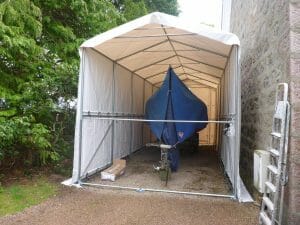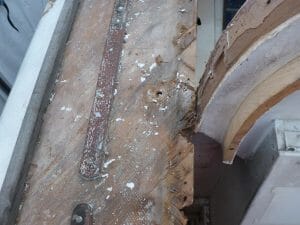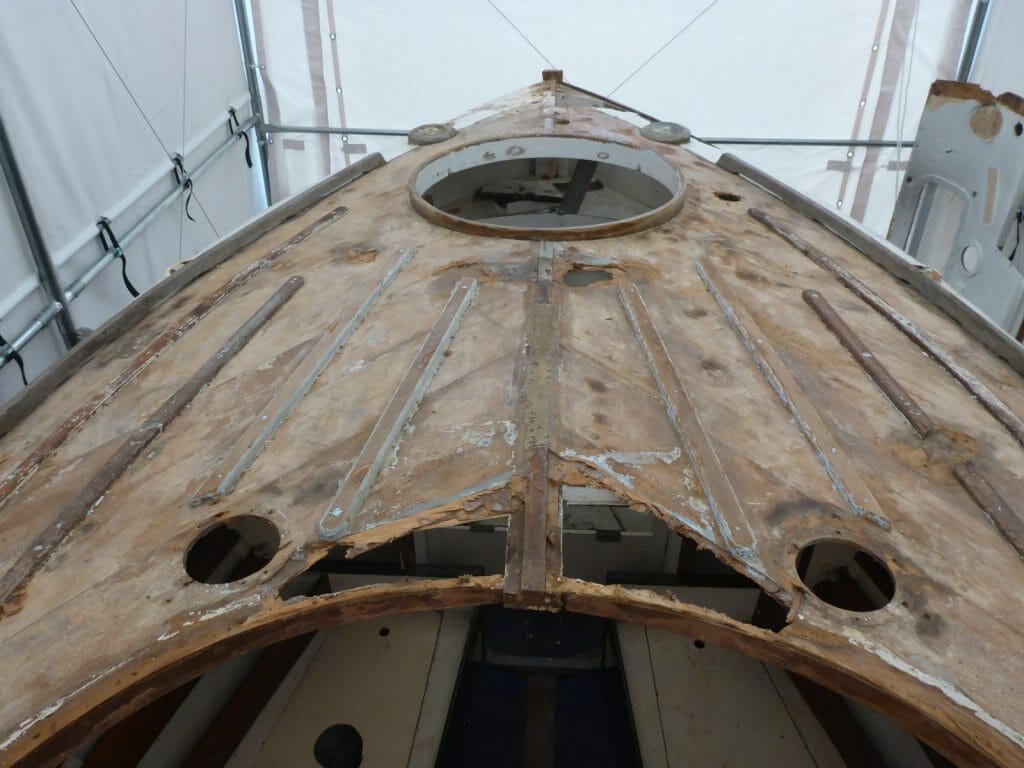Bluster is now under an all-weather cover so it is possible to work on her even when the weather is not as fine as it should be.
Many of the fittings have been stripped off, and today the coachroof was separated from the deck. This was quite a job, but needed doing as she had developed some major leaks at the deck-coachroof join over the last few years and the decks at the aft end of the coachroof had become quite weak. The biggest problem was that almost all the brass screws broke off – near the end of the screw if I was lucky, but usually just part of the head.
Where the wood had remained dry, the original glue was still quite strong, but dampness had allowed various parts to delaminate and separate easily.
I am thinking of supporting the deck below the coachroof aft of the main bulkhead in the same way that it is supported forward of this bulkhead in the main cabin, with a wooden beam under the join and a thin board glued to this and to the coachroof. This should stiffen it up and prevent the join from opening up and letting the water in, for a while at least!
-
A183 Bluster’s tent
-
A183 Almost a dinghy with windows.
-
A183 The new flush decked Atalanta Bluster
-
A183 Rot and delamination at the base of the coachroof
-
A183 The foredeck without paint or fittings











Jonathan
Interesting! Thanks for the further info.
That central join was shot on Helene too, but Helene does have a stainless steel post where the blister joins the kingplank.
… the same, but not the same!
Cheers
Nick
Nick,
The deck-coachroof reinforcement is original, but only forward of the main bulkhead. It comprises two curved strips laminated from 5 or 6 3mm Agba veneers glued to the underside of the deck and screwed to two deck frames and one deck stringer. Covering this is a 4mm strip of Mahogany glued to this curved strip and the coachroof above. Mainly cosmetic, but also adding some rigidity. Aft of the main bulkhead to the cockpit the only reinforcement is the quarter round.
The weak point in the cabin is where the curved strips meet on the centreline. These strips and the central deck stringer all meet with no screws, only glue. I presume the rigidity is provided by the deck (which also joins on this central stringer) and the curved front of the coachroof (which is also showing signs of strain at this point). I have seen Atalantas that have a vertical post at this point to support the deck, but Bluster has never had one as far as I know. It would get in the way of our large table (not original).
On the website recently (makers plate correspondence?) I did see an example of some internal reinforcement of the deck-coachroof join aft of the main bulkhead.
Regards,
Jonathan
Jonathan
Thanks for the update on Bluster’s progress.
Wow. I love your all-weather cover – very cosy and will make a big difference removing the dependency on fine weather.
I am intrigued about your description of the blister-deck join/sidedeck support. As you say it seems to make sense. Was this original? On Helene, a much earlier boat, the only structural component in the blister-deck join is the external quadrant. There are trim pieces internally to cover the join but they offer no support. (Perhaps I should expoxy them in place…..)
It is interesting to see the boat without the blister. A flush-decked Atalanta is an interesting idea (see image below). It might need a mast extension and access to the forecabin might require crew to be quite flexible. And perhaps you would need a short cook / navigator?
Please keep the updates coming
Cheers
Nick